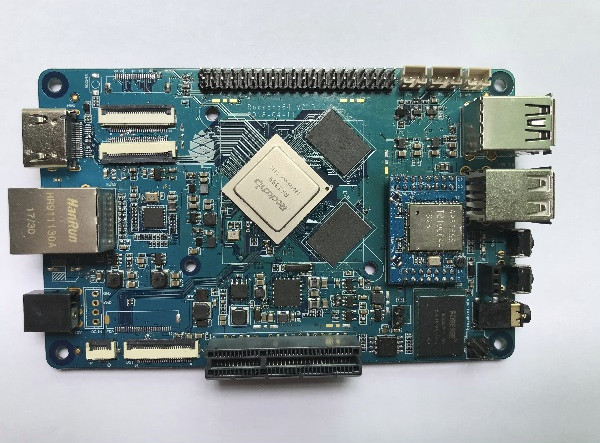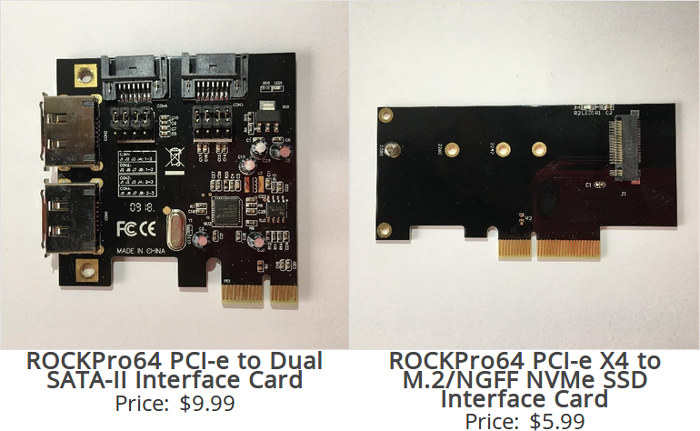Several Rockchip RK3399 development boards and SBCs were announced or launched in Q4 2017 / Q1 2018, including Orange Pi RK3399, ODROID-N1, Rock960, etc…
RockPro64 was the most aggressively priced of the lot as it was expected to launch for about $60. The good news is that Pine 64 is now selling the first production batch for $59.99 (2GB RAM) or $79.99 (4GB RAM). The less good news is that software is still being worked on so the company only recommends it for early adapters and developers.
 RockPro64 specifications have changed a bit since the board now comes with LPDDR4 memory instead of LPDDR3:
RockPro64 specifications have changed a bit since the board now comes with LPDDR4 memory instead of LPDDR3:
- SoC – Rockchip RK3399 hexa-core processor with 2x ARM Cortex A72 cores up to 2.0 GHz, 4x Cortex A53 cores, and an Arm Mali-T860 MP4 GPU
- System Memory – 2 or 4 GB LPDDR4, dual channel
- Storage – eMMC flash module (up to 128 GB), micro SD card (bootable), 128 Mbit SPI flash
- Video Output & Display Interfaces
- HDMI 2.0 output
- eDP connector
- MIPI DSI connector + TP connector + backlight supply
- DisplayPort via USB type C
- Audio – ES8316 Audio Codec; Headphone/MIC jack
- Connectivity – Gigabit Ethernet, SDIO socket for optional 802.11ac WiFi and Bluetooth 4.1 LE module
- USB – 2x USB 2.0 host ports, 1x USB 3.0 port, 1x USB 3.0 type C port with DisplayPort Alt-mode
- Camera – Parallel CSI, 2x MIPI CSI
- Debugging – 3-pin serial header
- Expansion
- PI-2 Bus 40-pin GPIO header (I2C/SPI/I2S/UARTs/GPIOs)
- PCIe x4 open ended slot
- Misc – Heatsink mounting holes + fan header, Power/Reset/Recovery buttons, IR receiver
- Power Supply – 12V DC input via power barrel jack (12V/3A recommended for most case. 12V/5A may be needed for power hungry PCIe card)
- Dimensions – 133mm x 80mm x 19mm (Same as Pine64 board)
I could not find documentation nor firmware images yet, but I’ve been told that Rock64 images (Debian, Ubuntu, Android, etc..) work with some tweaks such as updated Device Tree (.dts) file. The boards are expected to ship in the first week of May, so we should have more clarity about available firmware images at that time.
 The boards do not ship with all accessories by default so you may want to add the heatsink ($2.99) a power supply ($8.99 to $11.99), and optionally the wireless module ($14.99), as well as PCIe card to connect two SATA drives ($9.99), or an M.2 NVMe SSD ($5.99).
The boards do not ship with all accessories by default so you may want to add the heatsink ($2.99) a power supply ($8.99 to $11.99), and optionally the wireless module ($14.99), as well as PCIe card to connect two SATA drives ($9.99), or an M.2 NVMe SSD ($5.99).
[Update: You may be interested in our RockPro64 RK3399 Board Linux Review with Ubuntu 18.04 + LXDE.

Jean-Luc started CNX Software in 2010 as a part-time endeavor, before quitting his job as a software engineering manager, and starting to write daily news, and reviews full time later in 2011.
Support CNX Software! Donate via cryptocurrencies, become a Patron on Patreon, or purchase goods on Amazon or Aliexpress. We also use affiliate links in articles to earn commissions if you make a purchase after clicking on those links.




